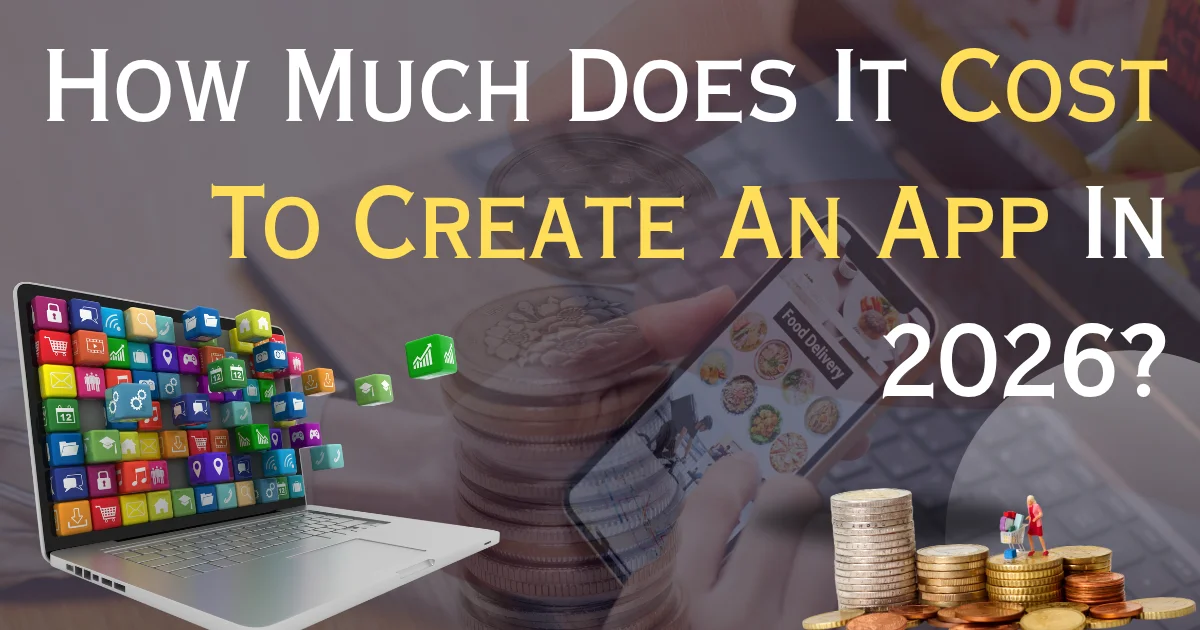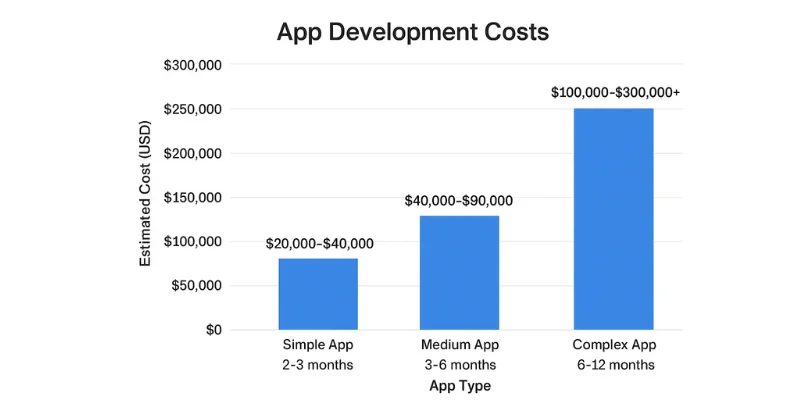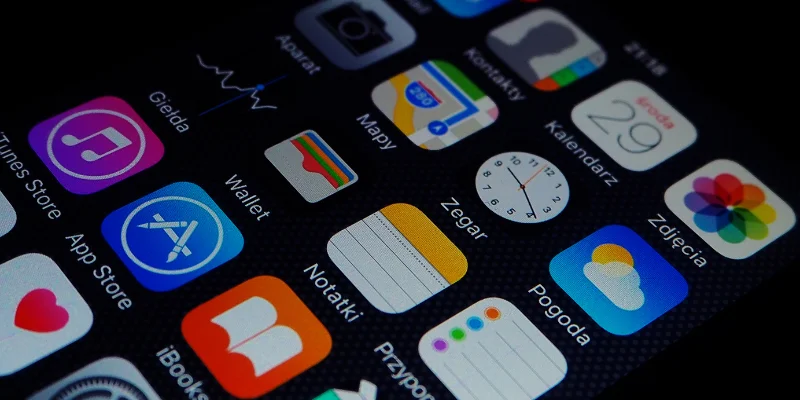Sales Team
Project quotes, partnerships, implementation

In 2026, mobile apps remain the heart of digital innovation. From small startups to global enterprises, every business wants to develop an app that enhances customer engagement, boosts revenue, and improves brand loyalty. But the most common question before starting any project is — “How much does it cost to create an app?”
The mobile app development cost depends on many factors such as complexity, design, platform, technology stack, and developer location. In this detailed guide, we’ll explore everything you need to know about the cost to develop an app, how pricing is estimated, how you can optimize your application development cost without compromising quality, and how to produce an app.
Before hiring mobile app developers or an app developing company, it’s crucial to understand the total investment required. Many businesses underestimate the cost of app development and face budget overruns later.
Knowing the mobile application development cost in advance helps you:
Create a clear project roadmap and timeline
Estimate return on investment (ROI)
Choose the right companies that develop apps
Avoid unexpected app-making charges
Allocate funds for maintenance and marketing
A well-planned budget ensures your mobile development journey remains smooth, efficient, and profitable.
If you’re wondering how much it costs to create an app in 2026, the answer depends on several factors — your app’s complexity, features, design, and the platform you choose. On average, the mobile app development cost ranges from $25,000 to $300,000 or more. The exact budget depends on whether you want to build a simple app with basic functions or a complex solution powered by AI, AR/VR, or IoT.
Here’s a clear breakdown of the average price to develop an app based on its type and scope:
The cost to develop an app is directly linked to the time, technology, and expertise required. A simple mobile app like a calculator, to-do list, or basic booking app—has fewer screens and minimal backend features, making it faster and cheaper to develop.
A medium-complexity app, such as a fitness tracker or eCommerce app, includes additional elements like user authentication, in-app payments, and API integration. These functionalities require more time and skilled mobile app developers, which increases the app development cost.
On the other hand, a complex app that uses cutting-edge technologies like Artificial Intelligence (AI), Internet of Things (IoT), or Augmented Reality (AR) requires extensive coding, testing, and cloud integration. As a result, the cost of app development can exceed $300,000 depending on your requirements and desired user experience.

So, how expensive is it to create an app today? It truly depends on your goals and how you plan to scale. If you’re just starting out, you don’t need to spend a fortune. Many successful startups begin with an MVP (Minimum Viable Product) — a simplified version of the app that includes only the essential features.
Building an MVP allows you to:
Test your idea in the market
Gather user feedback
Avoid unnecessary expenses
Reduce total mobile application development cost
Once your MVP gains traction, you can gradually expand your features, integrate advanced technology, and enhance the design — all while keeping your cost to make a mobile app under control.
If you’re unsure how to produce an app efficiently, consulting with a custom mobile app development company can help you plan the best strategy for your goals and budget. Professional app developers can guide you through choosing the right tech stack, design elements, and features that balance quality with affordability.
Before you decide how much to create an app, start with clear goals and a defined scope. Identify must-have features versus nice-to-have ones. This approach will not only help you manage your app development cost but also reduce time-to-market — ensuring your app launches faster and performs better.
Whether you want to build a basic Android app or a full-scale cross-platform solution, understanding the cost to build an app early in the process helps you plan smarter and avoid budget surprises.
Every mobile app is unique — and so is its price. Whether you’re planning to develop an app for Android, iOS, or both, several key factors determine how much it costs to create an app. Understanding these elements helps you plan your budget wisely and ensures you get the best return on your investment.
Let’s break down the major factors that influence mobile app development cost in 2026 and beyond.
The biggest factor impacting the cost of app development is the complexity of your app and the number of features you want to include.
A simple mobile app may have only a few screens, limited interactivity, and basic functionality like login, profile management, and notifications.
However, a complex app like Uber, Instagram, or Amazon includes:
Geolocation & interactive maps
Real-time chat and push notifications
Payment gateway integration
AI-powered analytics and automation
Real-time data synchronization
Secure cloud storage
Each added feature increases the app development cost, as it requires additional design, development, and testing efforts.
If you’re just starting to create a mobile app, focus on the core features first. You can expand later based on user feedback — this strategy keeps your cost to make a mobile app under control while still launching a strong product.
The platform you choose has a direct impact on the overall mobile app development cost.
iOS App Development:
Developing for iOS often involves less device fragmentation and faster testing. It’s popular among high-income markets, making it ideal for premium products.
Android App Development:
Android apps reach a larger audience but require more testing across different devices. Working with an experienced Android app development company ensures smooth performance and compatibility.
Cross-Platform App Development:
Technologies like Flutter, React Native, or Xamarin allow developers to build apps for both Android and iOS using a single codebase. This can reduce the total cost of app development by up to 40%, while still delivering high-quality performance.
If you’re unsure how to create an app for multiple platforms, consulting professional app developers will help you decide the right technology for your goals and target users.

A well-designed app not only attracts users but also keeps them engaged. The UI/UX design stage plays a huge role in determining the mobile application development cost.
On average, UI/UX design can range between $5,000 and $30,000, depending on design complexity, custom animations, and branding consistency.
Hiring a professional app creator or custom mobile app development company ensures:
Clean, modern layouts
Smooth and intuitive navigation
Brand-aligned color themes
Accessibility and scalability for future updates
Investing in good design early can save you from costly redesigns later and improve your overall app development ROI.
The location and skill level of your mobile app developers significantly influence the cost to develop an app. Developers across the world charge different hourly rates depending on their expertise and regional cost of living.
Outsourcing your project to a reputable app developing company in India or Eastern Europe can help reduce your application development cost by up to 60%, while maintaining high quality and functionality.
For businesses with limited budgets, partnering with an experienced offshore mobile app development services provider is a smart, cost-effective choice.
Your app’s backend is its engine — it handles logic, data management, and user requests. The technology stack you choose plays a major role in determining the cost to build an app.
A simple backend for small apps might cost $10,000 to $20,000, while a complex backend with advanced integrations can go up to $50,000 or more.
Features that can increase your mobile development cost include:
AI-powered chatbots
IoT device connectivity
Real-time analytics dashboards
Secure payment and authentication systems
Common backend technologies include Firebase, AWS, and Google Cloud — each offering scalability and reliability. The better the infrastructure, the smoother your app’s performance — but also the higher the cost to make a mobile app.
Testing ensures your app performs smoothly across different devices, operating systems, and user scenarios. Typically, testing and QA take up around 15–25% of the total app development cost.
A reliable mobile app development company performs multiple rounds of testing, including:
Manual and automated testing
Usability and performance testing
Security and penetration testing
Load and stress testing
Thorough QA ensures your app is bug-free, secure, and ready for launch. Investing in quality testing reduces future maintenance costs and enhances your brand reputation — improving your overall mobile app development ROI.
App development doesn’t end at launch — it’s just the beginning. Continuous updates, feature enhancements, and bug fixes are vital for keeping users satisfied.
Typically, app maintenance costs account for 15–20% of the total mobile app development cost per year.
For example, if your app costs $50,000 to build, you can expect to spend around $8,000 to $10,000 annually on updates and improvements.
Maintenance includes:
Updating for new OS versions
Fixing bugs and crashes
Adding new features and content
Optimizing performance and security
Working with a custom mobile app development company that offers post-launch support ensures your app stays updated, secure, and relevant in the fast-changing mobile ecosystem.
The cost to develop an app depends on several stages of the development process, each contributing to the overall mobile app development cost. From discovery and design to deployment and maintenance, every phase requires specific expertise, tools, and time investment. Below is a detailed cost breakdown of app development by stages to help you understand where your budget goes and how much it costs to create an app efficiently.
This step-wise breakdown helps you visualize how the cost to make a mobile app is distributed throughout the process.
The cost to develop an app changes based on the type of app you want to create. Every app, whether it’s for shopping, social networking, healthcare, or gaming has different features, designs, and technology needs. These factors play a big role in deciding the total mobile app development cost. Below is a simple breakdown showing the average cost to create an app depending on its type.
Each type requires unique integrations and compliance standards, influencing how much to create an app.
Many businesses forget about additional expenses that add up after launch. Hidden app making charges include:
App store submission fees (Apple & Google)
Third-party service APIs
Data hosting and analytics tools
Marketing and ASO (App Store Optimization)
Customer support and updates
Always include these in your total cost to develop an app estimation.
If you’re wondering how much does app development cost and how to reduce it, follow these strategies:
Build an MVP (Minimum Viable Product): Focus only on must-have features first.
Choose Cross-Platform Development: Save time and resources by using Flutter or React Native.
Outsource Smartly: Work with experienced mobile app developers from cost-effective regions like India.
Plan Ahead: Avoid frequent scope changes after development begins.
Automate Testing: Reduces QA time and total cost to make mobile apps.
These smart steps help you lower your application development cost without compromising on performance or quality.
Your project’s success depends on your development partner. Here’s how to choose the best app developing company:
Check portfolio and case studies
Evaluate technical skills and tools
Ask for transparent pricing
Discuss maintenance support
Ensure strong communication
Choosing a reputed custom mobile app development company ensures your mobile development project is on time and on budget.
If you’re wondering how to develop an app from scratch, here’s a complete step-by-step guide that explains the process in detail. Following these stages helps ensure that your app is user-friendly, functional, and ready for market success.

1. Idea Generation:
Start by defining your app’s main purpose and the problem it solves. Identify your target audience and understand what value your app will offer them. This is the foundation of every successful mobile development project.
2. Market Research:
Before jumping into design or coding, conduct thorough research. Study your competitors’ apps, analyze market trends, and identify user preferences. This helps you understand what works and what doesn’t—saving you time and reducing the overall app development cost.
3. Wireframing:
Once you have your concept ready, create wireframes to outline your app’s layout and structure. Wireframing acts as a visual blueprint, helping you and your app developing company plan features, navigation, and screen flow efficiently.
4. UI/UX Design:
The design stage focuses on creating an attractive and smooth user experience. Skilled mobile app developers or designers use modern tools to build interfaces that are both visually appealing and easy to use. Good design directly impacts your app’s success and user retention.
5. Development:
This is where your idea becomes reality. App developers start writing the frontend and backend code, integrating APIs, databases, and required functionalities. You can hire a professional android app development company or custom mobile app development company to ensure quality and scalability.
6. Testing:
Before launching, every app undergoes multiple testing rounds. QA experts check for bugs, glitches, and performance issues. This step ensures your app runs smoothly on all devices and platforms—reducing future application development costs.
7. Deployment:
Once your app passes testing, it’s time to launch it on platforms like Google Play Store or Apple App Store. Deployment involves preparing your app’s metadata, optimizing descriptions, and ensuring compliance with store policies.
8. Maintenance:
After launch, continuous support and updates are crucial. Regular maintenance keeps your app secure, adds new features, and improves performance. Keep in mind that maintenance costs are a part of your ongoing mobile app development cost each year.
As technology continues to evolve, the mobile app development cost in 2026 and beyond will be heavily influenced by new innovations and user expectations. Businesses looking to develop an app must stay ahead of these trends to remain competitive and deliver high-performance digital solutions. Below are the top trends shaping the cost to develop an app in the coming years:
1. Artificial Intelligence (AI) and Machine Learning (ML):
AI and ML are revolutionizing how apps deliver personalized user experiences. From chatbots and voice recognition to predictive analytics and automation, these technologies improve engagement and retention. However, integrating AI features can increase the app development cost due to the need for advanced algorithms and data processing tools
Want to explore the top companies that provide artificial intelligence services? Check out our detailed blog on Artificial Intelligence Services Companies for expert insights and industry leaders.
2. Internet of Things (IoT):
IoT-powered applications are becoming essential in industries like healthcare, logistics, and smart homes. Developing IoT apps requires complex backend systems, device integration, and high-level security, which can impact the overall mobile application development cost. Still, IoT brings immense value through real-time data and automation.
3. Blockchain-Based Security:
Blockchain technology is transforming data privacy and transaction security. Integrating blockchain into apps—especially fintech, eCommerce, and healthcare apps—offers transparency and trust but adds to the cost of app development due to the complexity of smart contracts and secure architecture.
4. Wearable Integrations:
With the growing popularity of smartwatches and fitness trackers, wearable integrations are in high demand. Apps with wearable compatibility require specialized APIs and sensor connectivity, which can increase the cost to make a mobile app, but they also improve user engagement and accessibility.
5. 5G Connectivity:
The rollout of 5G will make apps faster, more responsive, and more capable of handling advanced features like AR, VR, and real-time analytics. While adapting apps for 5G-ready performance may increase app development costs slightly, it ensures better user experience and long-term scalability.
6. Augmented Reality (AR) and Virtual Reality (VR):
AR and VR technologies are reshaping industries like gaming, retail, and education. Adding immersive experiences requires high-quality graphics and specialized development frameworks, which can affect how much it costs to create an app. However, these technologies significantly boost engagement and brand value.
When it comes to choosing a reliable custom mobile app development company, SISGAIN stands out as a global leader.
SISGAIN offers:
Expert mobile app developers skilled in the latest technologies
Affordable mobile app development services for startups and enterprises
Transparent pricing and detailed cost breakdowns
End-to-end solutions from design to deployment
24/7 maintenance and post-launch support
Whether you want to develop an app from scratch or enhance your existing one, SISGAIN helps reduce your cost to develop an app while ensuring quality, security, and scalability.
Their team of talented app developers turns your ideas into high-performance, user-friendly apps that drive real business growth.
So, how much does it cost to create an app in 2026?
The answer depends on your app’s type, platform, and complexity. A simple app may cost $25,000, while a complex enterprise solution could exceed $300,000.
By understanding all cost factors, planning strategically, and partnering with experienced professionals like SISGAIN, you can develop a high-quality app within your budget.
Building an app isn’t just about cost — it’s an investment in your business’s digital future. With the right partner and planning, your app can become the foundation of your brand’s success.
Project quotes, partnerships, implementation
Open roles, referrals, campus hiring